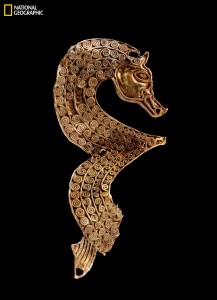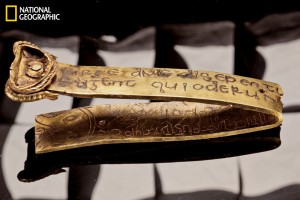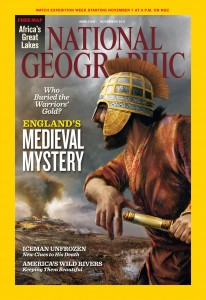Magic Mystery Treasure
in the November 2011 issue of National Geographic
The Staffordshire Hoard, as it was quickly dubbed, electrified the general public and Anglo-Saxon scholars alike. Spectacular discoveries, such as the royal finds at Sutton Hoo in Suffolk, had been made in Anglo-Saxon burial sites. But the treasure pulled from Fred Johnson’s field was novel—a cache of gold, silver, and garnet objects from early Anglo-Saxon times and from one of the most important kingdoms of the era. Moreover, the quality and style of the intricate filigree and cloisonné decorating the objects were extraordinary, inviting heady comparisons to such legendary treasures as the Lindisfarne Gospels of the Book of Kells.
Once cataloged, the hoard was found to contain some 3,500 pieces representing hundreds of complete objects. And the items that could be securely identified presented a striking pattern. There were more than 300 sword-hilt fittings, 92 sword-pommel caps, and 10 scabbard pendants. Also noteworthy: There were no coins or women’s jewelry, and out of the entire collection, the three religious objects appeared to be the only nonmartial pieces. Intriguingly, many of the items seemed to have been bent or broken. This treasure, then, was a pile of broken, elite, military hardware hidden 13 centuries ago in a politically and militarily turbulent region. The Staffordshire Hoard was trilling and historic—but above all it was enigmatic.
Read more online here: http://ngm.nationalgeographic.com/featurehub
The photos below can be viewed in the November 2011 issue of National Geographic http://ngm.nationalgeographic.com/2011/11/gold-hoard/clark-photography
©Robert Clark/National Geographic
On a farm near his home Terry Herbert shows off the metal detector that led him to the gold. “I just couldn’t stop the items from coming out of the ground,” he says. He received half the treasure’s assessed value of almost $5.3 million.
©Robert Clark/National Geographic
A figure pocked with nail holes may represent a horse—or a bear, or a boar, or even a wolf. Just 1.6 inches high, it was made by a master goldsmith who knew how to heat the metal almost to melting point to attach the tiny swirls. All artifacts owned by: Birmingham Museums and Art Gallery; Potteries Museum and Art Gallery, Stoke-on-Trent.
©Robert Clark/National Geographic
A strip of gold once studded with a gem bears the same biblical quotation in Latin on each side: Moses’ declaration, translated above, as the Israelites journeyed out of Sinai. The object may have decorated the arm of a cross prized by recent converts to Christianity. All artifacts owned by: Birmingham Museums and Art Gallery; Potteries Museum and Art Gallery, Stoke-on-Trent.
Also, on October 29, the National Geographic Museum will open an exhibit on the hoard featuring pieces from the collection! In addition, ‘Lost Gold: War, Treasure, and theMystery of the Saxons’ has just been published- the trailer can be seen here: http://www.youtube.com/watch?v=o1p6dPOQ_AY



